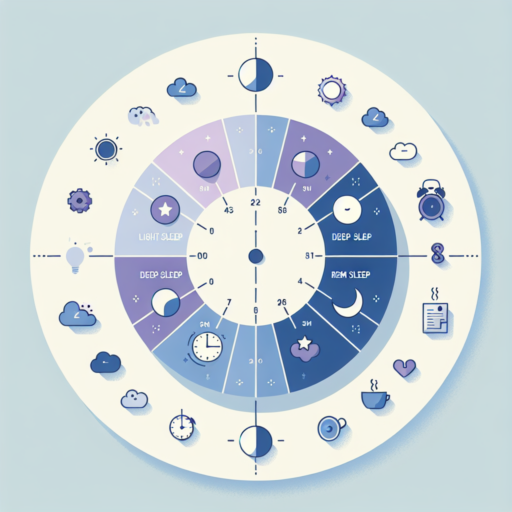What are the 5 stages of the sleep cycle?
Understanding the 5 stages of the sleep cycle is crucial for recognizing how sleep affects our bodies and minds. These stages are categorized into Non-REM (Rapid Eye Movement) and REM sleep, which alternately cycle through the night.
The Stages of Non-REM Sleep
The first four stages are part of Non-REM sleep. The initial stage is where we transition from wakefulness to sleep. It’s a light sleep from which we can be easily awakened. The brain produces high amplitude theta waves, which are slower than the alpha waves produced when we are awake and relaxed.
Moving into the second stage, our body begins to prepare for deep sleep. Heart rate and body temperature drop, and we start to disengage from our surroundings. This stage features sleep spindles and K-complexes, which are thought to protect the brain’s sleep state and help with memory consolidation.
Stages three and four are categorized as deep sleep or slow-wave sleep. Here, delta brain waves dominate, and it becomes hard to wake someone up. It’s during these stages that the body focuses on healing and growth, repairing tissue, strengthening the immune system, and building bone and muscle.
REM Sleep: The Dream Stage
Following the deep sleep of the fourth stage, we enter the REM stage, which is markedly different. This is where dreams occur. Our brain becomes more active, and our eyes dart back and forth rapidly behind our eyelids, hence the name Rapid Eye Movement sleep. Despite the increase in brain activity, our bodies remain very relaxed due to muscle atonia to prevent us from acting out our dreams.
Each of these stages plays a vital role in ensuring we wake up feeling rested and rejuvenated. Progressing through the stages of the sleep cycle is essential for both physical health and cognitive function.
What is the ideal sleep cycle?
Understanding the ideal sleep cycle is critical for optimizing health and well-being. The human body operates on a roughly 24-hour cycle known as the circadian rhythm, which plays a key role in determining our sleep patterns. Within this cycle, the body goes through various stages of sleep, each crucial for rejuvenation and recovery.
Typically, an ideal sleep cycle includes both deep (non-REM) and light (REM) sleep and lasts about 90 minutes, repeating several times throughout the night. Experts often recommend between 7 to 9 hours of sleep for adults, which corresponds to about 5 to 6 cycles of sleep. It’s during the deep sleep stages that the body repairs tissues, stimulates growth and development, and boosts immune function.
To achieve and maintain an ideal sleep cycle, maintaining a consistent sleep schedule is important. Going to bed and waking up at the same time every day helps regulate your body’s internal clock and improves the quality of your sleep. Avoiding caffeine and electronic devices before bedtime can also help in maintaining a healthy sleep cycle.
No se han encontrado productos.
Is a sleep cycle 3 hours?
Understanding the length of a sleep cycle is crucial for achieving optimal rest and maintaining overall health. While the idea of a 3-hour sleep cycle may seem appealing or efficient, especially for those with hectic schedules, it’s essential to explore how closely this concept aligns with our natural sleep patterns. Sleep cycles are typically measured in terms of how they alternate between different sleep stages, including light sleep, deep (or slow-wave) sleep, and REM (rapid eye movement) sleep.
Diving Into Sleep Cycle Length
Sleep experts have thoroughly researched the intricacies of sleep cycles, finding that an average cycle lasts approximately 90 minutes. Over the course of a typical night’s rest, an individual would cycle through these stages multiple times, culminating in a recommended total sleep time of around 7 to 9 hours for adults. This longer duration is essential for facilitating the various critical functions that sleep stages serve, such as memory consolidation, cognitive function restoration, and muscle repair. A 3-hour total sleep time significantly truncates this process, likely impacting overall wellbeing and performance.
Considering Short Sleep Cycles
While the concept of a 3-hour sleep cycle is not typically supported by sleep scientists, there are discussions around polyphasic sleep schedules. These schedules break down the day’s total sleep requirement into several shorter periods. Adherents might feel tempted to adopt a trio of 3-hour sleep cycles in a 24-hour period. Despite this, it is vital to note that such practices can disrupt the body’s internal clock and the natural progression through sleep stages, potentially leading to sleep deprivation and a host of related health issues.
In summary, while the body’s need for sleep might vary slightly from person to person, aligning sleep patterns with natural cycles is key. Attempting to condense sleep into 3-hour increments could misalign with what is typically recommended by health professionals, suggesting the need for further exploration and consideration of the impacts on health and daily functioning.
How many cycles is a good sleep?
Discussing how many cycles constitute a good sleep is crucial in understanding and improving our sleep quality. Sleep is not just a matter of hours spent in bed but also about the number and quality of sleep cycles we complete. A typical sleep cycle lasts about 90 minutes and goes through several stages, including light sleep, deep sleep, and REM (Rapid Eye Movement) sleep. For a healthy adult, achieving 4-6 cycles is considered beneficial for both physical and mental health.
In diving into the details, it’s important to consider that each cycle plays a unique role. For instance, deep sleep helps with physical recovery and memory consolidation, while REM sleep, where most dreaming occurs, is key for emotional and mental health. This interplay suggests that earning a good night’s rest means attaining a balance between the quantity and quality of sleep cycles, rather than merely focusing on the overall hours slept.
Variability exists among individuals on how many cycles are truly optimal. Factors such as age, lifestyle, and specific health conditions play a significant role in determining the ideal number of cycles one should aim for. For example, children and teens, who are in crucial stages of growth and development, may require more sleep cycles compared to adults. Recognizing and adapting to these individual needs is essential for fostering a sleep pattern that promotes optimal health and well-being.


